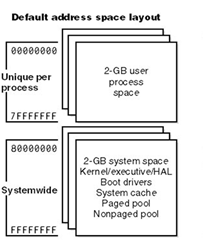
- /3GB won't enable you to see the additional 4GB or 8GB of RAM you added to your new server
- /3GB doesn't necessarily make your application 50% more efficient
- /3GB should not be a standard for your environment (there are exceptions, and we'll get to those)

So where does the /3GB switch come in? Windows 2000 Advanced Server, Windows 2000 Datacenter Server, Windows XP SP2 and later and all versions of Windows Server 2003 support the /3GB boot-time option to allow the user mode address space to grow to 3GB. The /3GB option was intended as a short term solution to allow applications such as database servers to maintain more data in memory than a 2GB address space allowed. However, using the /3GB method to increase the user-mode memory space comes at a cost.

| Default OS Build: | |
| Free System PTE's | 251,980 (1,007,920 kb) |
| NonPaged Pool Max | 206,848 kb |
| With /3GB enabled: | |
| Free System PTE's | 34,884 (139,536 kb) |
| NonPaged Pool Max | 129,312 kb |
As you can see, the Free System PTE's drops by over 200,000. Keep in mind that this is only a test server that isn't under any sort of load. A machine under medium to heavy load could quite easily run out of free PTE's - meaning that the system can no longer map system pages such as I/O space, kernel stacks and memory descriptor lists. In addition, look at NonPaged Pool after the /3GB parameter is enabled. The NonPaged Pool maximum is only 130MB. Drivers use the NonPaged Pool for many of their requirements because they can be accessed at any IRQL. Once we run into NonPaged pool depletion, we're looking at our old friend, the Event ID 2019.
OK - so let's quickly recap what we've discussed so far. The /3GB switch is not related to the amount of physical memory installed in a system. It is useful if you have an application that can take advantage of a larger address space. For a process to access the full 3GB address space, the image file must have the IMAGE_FILE_LARGE_ADDRESS_AWARE flag set in the image header.
If the flag is not set in the image header, then the OS reserves the third gigabyte so that the application won't see virtual addresses greater than 0x7FFFFFFF. You set this flag by specifying the linker flag /LARGEADDRESSAWARE when building the executable. This flag has no effect when running the application on a system with a 2-GB user address space. Therefore if you enable the /3GB switch, then applications that do not have this flag set can only use the standard 2GB of User mode memory, and the Kernel is still limited to the 1GB space - which means that 1GB of virtual memory is basically wasted!
Earlier, we mentioned that there were some applications that benefit from the use of the /3GB switch. The predominant scenario where the /3GB switch is not only recommended, but actually required is with Microsoft Exchange servers that house public folders and / or mailboxes. Due to the way that Exchange handles memory management, the additional 1GB of user mode memory is required to ensure that the Store.exe process does not run out of virtual address space. However, in order to guard against System PTE depletion, the system can be tuned using the /USERVA switch in conjunction with the /3GB switch. This tunes the actual amount of memory for the Address space. For example, setting USERVA=3030 means that the process space is actually only 3,030MB and not 3,072MB (which would be the process space with only the /3GB switch present). The additional 42MB is used for System PTE usage. The USERVA value can safely be tweaked as low as 2800 - however, if it is necessary to set USERVA this low, then you probably want to start thinking about scaling your Exchange environment to spread the load!
Ideally, there should always be at least 24,000 Free System PTE's at boot time. Depending on server workload there may be wide variances in the amount of Free System PTE's during the course of a normal duty cycle, so it may be necessary to implement some long-term monitoring to ensure that the server does not fall below 10,000 Free PTE's.
So there you have it - the /3GB switch demystified. Hopefully this post, as well as the others in our Memory Management series will help you understand a bit more about how and why the Operating System behaves the way it does. Remember that the /3GB switch is intended to be used in very specific instances - and now you know why!
Additional Resources:
- Microsoft® Windows® Internals, Fourth Edition: Microsoft Windows Server™ 2003, Windows XP, and Windows 2000 (Chapter 7 covers Memory Management)
- Memory Management: What Every Driver Writer Needs to Know
- Windows DDK: /3GB
- Microsoft KB833721 Available switch options for the Windows XP and the Windows Server 2003 Boot.ini files
- Microsoft KB823440 Use of the /3GB switch in Exchange Server 2003 on a Windows Server 2003-based system
- Microsoft KB316739 How to use the /userva switch with the /3GB switch to tune the User-mode space to a value between 2 GB and 3 GB
- Microsoft KB810371 Using the /Userva switch on Windows Server 2003-based computers that are running Exchange Server
- Microsoft KB274750 Configuring SQL Server to use more than 2GB of Memory
- Raymond Chen: Summary of /3GB posts
 Microsoft
Microsoft